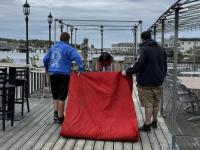Community service is now a graduation requirement
Old Orchard Beach does it.
Bucksport and Falmouth, and Damariscotta, too.
Community service is a graduation requirement at schools in these towns — from 20 to 40 hours.
At the May 14 CSD school committee meeting, Guidance Director Jen Burns and members of the ECHO/Student Volunteer Club (David Machon, Angela Machon and Mackenzie Colby) joined Burns for a presentation. The students are the driving force behind the proposal to enact a community service requirement at Boothbay Region High School (BRHS).
The club members suggested 20 hours to be completed throughout the high school years (grades nine through 12), but to do it in five-hour increments, beginning in the fall of 2014.
After discussion at its May 14 meeting, the school board unanimously approved trying it out.
Effective starting this fall: the Class of 2015 will need to have five hours of community service, the Class of 2016 will need 10 hours, the Class of 2017, 15 hours. The Class of 2018 will be the first to fulfill the full 20 hours.
Advisors in homeroom will keep track of hours and communicate with parents. Students will submit forms tracking their hours to include where they served and what work they performed. Students falling behind in their community service hours will be referred to Mrs. Burns or BRHS Principal Dan Welch.
Students at BRHS interested in community service have done so at the Boothbay Region Food Pantry and the Boothbay Region Historical Society. Other nonprofits on the high school's website include Habitat for Humanity, Rebuilding Together and www.volunteerme.org.
Burns said to qualify as community service the student would have to work for a nonprofit entity or organization. The Lincoln County Animal Shelter has agreed to participate, but students must be accompanied by an adult. The food pantry also welcomes more student volunteers.
Burns said she is currently contacting other groups to see if they are interested in participating in this program.
Angela Machon stated some of the benefits in requiring community service for all students were: it looks good on college applications, it was a way to become involved in something outside of school, and it helped students to get to know their community.
Burns said they all looked at other schools websites to see what they considered community service, and that was any work for an organization, club or group that was unpaid. Informal work done for family and/or neighbors couldn't be put toward community service totals.
Burns believes that as she continues to contact organizations, and as increased numbers of students go out into the community, the program will catch fire.
“We're hoping we can get into a pattern where community organizations will call us,” Burns said.
Some of the issues surfacing at the schools already mandating community service reported by the students were: advisors failed to keep accurate records, the effects of weather on locations, and lack of transportation for students to service sites. Indoor activities would have to be provided during the winter months.
In an attempt to control the weather issue, school committee member Brian Blethen suggested community service work at the school — painting, gardening, etc.
David Machon said the reason they were primarily looking outside the school was to broaden students' feel for the community.
With regard to the transportation issue, the students presenting suggested the school should provide it.
King asked if Community Service Day hours could be put toward the total hours, Burns said it would, however David Machon said those hours could not be used exclusively to fulfill the requirement.
School Committee member Sandy Paxson added that in addition to helping students get to know the community, service also helped the community get to know the students.
Event Date
Address
United States






















